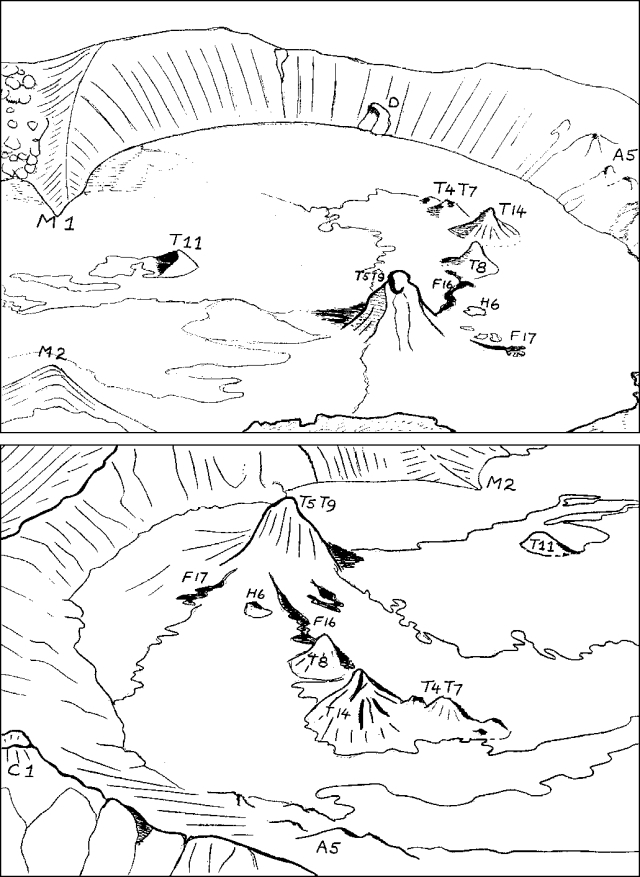Report on Ol Doinyo Lengai (Tanzania) — August 1990
Bulletin of the Global Volcanism Network, vol. 15, no. 8 (August 1990)
Managing Editor: Lindsay McClelland.
Ol Doinyo Lengai (Tanzania) Continued lava extrusion onto crater floor
Please cite this report as:
Global Volcanism Program, 1990. Report on Ol Doinyo Lengai (Tanzania) (McClelland, L., ed.). Bulletin of the Global Volcanism Network, 15:8. Smithsonian Institution. https://doi.org/10.5479/si.GVP.BGVN199008-222120
Ol Doinyo Lengai
Tanzania
2.764°S, 35.914°E; summit elev. 2962 m
All times are local (unless otherwise noted)
The volcano was visited twice in July, during a hike to the crater rim on 3 July by Thad Peterson and others, and an overflight on 9 July by L. Eshelman and G. Price. No liquid lava was visible on 3 July, but apparent heat-shimmering was observed above vent T5/T9 (now almost level with the E rim of the crater) and a surf-like roar was heard emanating from a source on the NE side of the crater. A strong sulfur odor originating from the N rim (near cone C) was reported during the overflight.
Comparison of photos taken by Eshelman during the 9 July overflight (figure 17) with those from a 2 May overflight indicated changes in lava flow and cone morphology . . . . Fresh lava, of various shades of mid to dark gray suggesting emission during the previous few weeks, covered roughly 90% of the crater floor. The remaining 10% was covered by older, white and pale gray lava. T5/T9, a large broad cone with a blunt peak, continued to be the primary source of lava, although it remained approximately the same size and shape. Fresh, dark gray lava flows extended from inconspicuous vents on the lower N, NE, and SW slopes of T5/T9, covering T10, surrounding H6, T8, T4/T7, and T11, and continuing S through the saddle M1M2. The youngest flows, F16 and F17, may have been liquid 9 July. A dark mark on T5/T9's N slope suggested a large vertical vent and almost the entire cone was dark gray, probably coated with fresh spatter from small vents on the upper slope.
The enlarged cone at the E end of T4/T7, newly designated as T14, was medium gray in color and had a number of large cracks on its slopes. It did not appear as fresh as the top of T5/T9, so it was believed to have formed in May or early June. T8 remained unchanged in shape since 2 May, but an increase in yellow sulfur deposition was noted. T11 was unchanged and appeared inactive. Cones along the crater walls (A5, C1, and D), appeared unchanged and showed no signs of fresh lava.
Geological Summary. The symmetrical Ol Doinyo Lengai is the only volcano known to have erupted carbonatite tephras and lavas in historical time. The prominent stratovolcano, known to the Maasai as "The Mountain of God," rises abruptly above the broad plain south of Lake Natron in the Gregory Rift Valley. The cone-building stage ended about 15,000 years ago and was followed by periodic ejection of natrocarbonatitic and nephelinite tephra during the Holocene. Historical eruptions have consisted of smaller tephra ejections and emission of numerous natrocarbonatitic lava flows on the floor of the summit crater and occasionally down the upper flanks. The depth and morphology of the northern crater have changed dramatically during the course of historical eruptions, ranging from steep crater walls about 200 m deep in the mid-20th century to shallow platforms mostly filling the crater. Long-term lava effusion in the summit crater beginning in 1983 had by the turn of the century mostly filled the northern crater; by late 1998 lava had begun overflowing the crater rim.
Information Contacts: C. Nyamweru, Kenyatta Univ.


